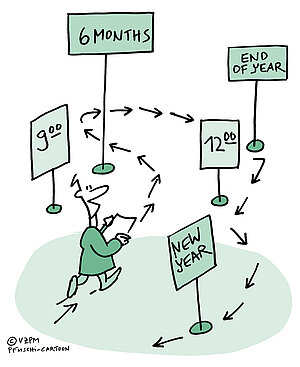Time
Definition
Time includes the identification and structuring of all components of a project in time in order to optimise the execution.
Purpose
The purpose of this competence element is to enable the individual to define, sequence, optimise, monitor and control all components necessary to delivering the agreed outcomes of the project.
Description
The aim of time scheduling is to determine what activities need to be carried out when, in order to optimise the execution of the project. For projects, the activities or components include work packages and phases.
In the case of projects, these activities have to be analysed and sequenced in time, their duration estimated and visualised in a schedule and assigned to people or teams, to have them executed in optimal order. Time also covers monitoring variances and deviations. Deviations in execution of the schedule, whether caused by external influences (changes in deliverables, requirements, scarcity of resources or money, etc) or internal ones (e.g. late or off-spec deliveries) may require rescheduling. Periodically, the schedule should be compared with the baseline and, if necessary, adjustments made. With iterative planning, the schedule may be divided into time boxes with a certain length. With each iteration, a certain sequence of activities (e.g. design, execution, test and implementation) may be defined. The overall project planning then focuses on the number of iterations and other activities (e.g. preparation, monitoring, etc). Where there is uncertainty about the timeframe required for a particular phase or activity, a time ‘buffer’ or ‘float’ should be introduced into the schedule.
Key competence indicators
Establish the activities required to deliver the project
Based on an analysis of the deliverables and/or requirements, preferably through a work breakdown structure (WBS), the activities necessary to achieve agreed results are defined. With iterative planning, the individual focuses on defining only the activities necessary for the agreed deliverables of the current iteration.
Measures
- Defines activities related to the realisation of project deliverables
- Extracts activities from a WBS work package
Determine the work effort and duration of activities
For each activity the work effort and duration necessary for realisation has to be determined. This includes determining what resources and resource competences, and how much, are required for each activity. When several resources (both material and personnel) are available, a balance has to be found between quality, cost and speed of delivery. This balance depends on the project success criteria and requirements.
Measures
- Determines work effort and duration of activities
- Identifies types of resources that may be required to perform an activity
- Identifies and decides between various resource options
Decide on schedule and stage approach
Depending on the chosen approach for the project (e.g. waterfall or iterative planning), a decision has to be made on the number, content, length and deliverables of the stages (or phases). The selection of a particular path very much depends on the specifics of the project success criteria and requirements, guidelines in the organisation and other contextual factors, uncertainty, etc. For instance, higher uncertainties may lead to shorter phases.
Measures
- Knows different planning techniques
- Chooses the appropriate planning techniques
- Determines appropriate stages
- Knows the effects of uncertainty on planning; and what to do to minimise the effects
Sequence project activities and create a schedule
Many activities are dependent on availability or on previous realisation of other work packages or activities. Based on these known dependencies and the calculated duration of each activity, an activity flow can be defined. From this, the critical path can be calculated. This critical path may be influenced by the availability of resources. The activity of levelling can optimise the assignment of resources in the planning and may influence the critical path.
Measures
- Sequences a series of project activities
- Determines dependencies and dependent relationships
- Calculates the critical path
- Levels resource assignment for a given plan
Monitor progress against the schedule and make any necessary adjustments
As soon as the planning is done and activities are started, control systems (such as time-writing systems and progress meetings) should be in place. Various methods, such as earned value analysis, can be used to measure realised progress versus baseline. A project plan may be subject to many disturbances, resulting in necessary adjustments. These may come from various sources (changes in deliverables, requirements, scarcity of resources or money or late or off-spec deliveries) and may demand re-planning. Periodically, the schedule should be compared against the baseline and, if necessary, adjustments should be made.
Measures
- Knows when and how to use various schedule control systems
- Applies planning adjustments in response to various types of disturbances
- Compares progress and earned value against a baseline plan


